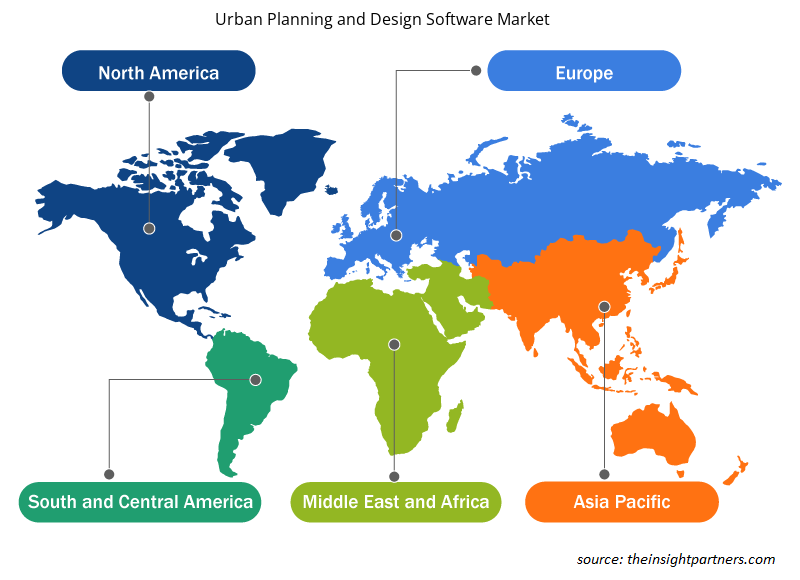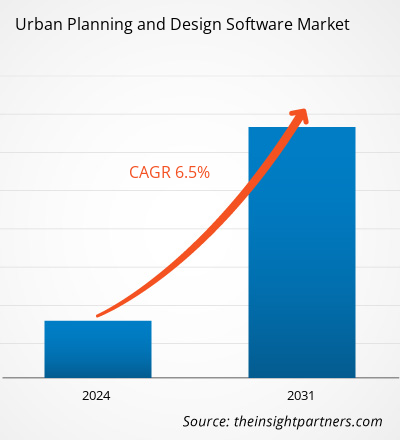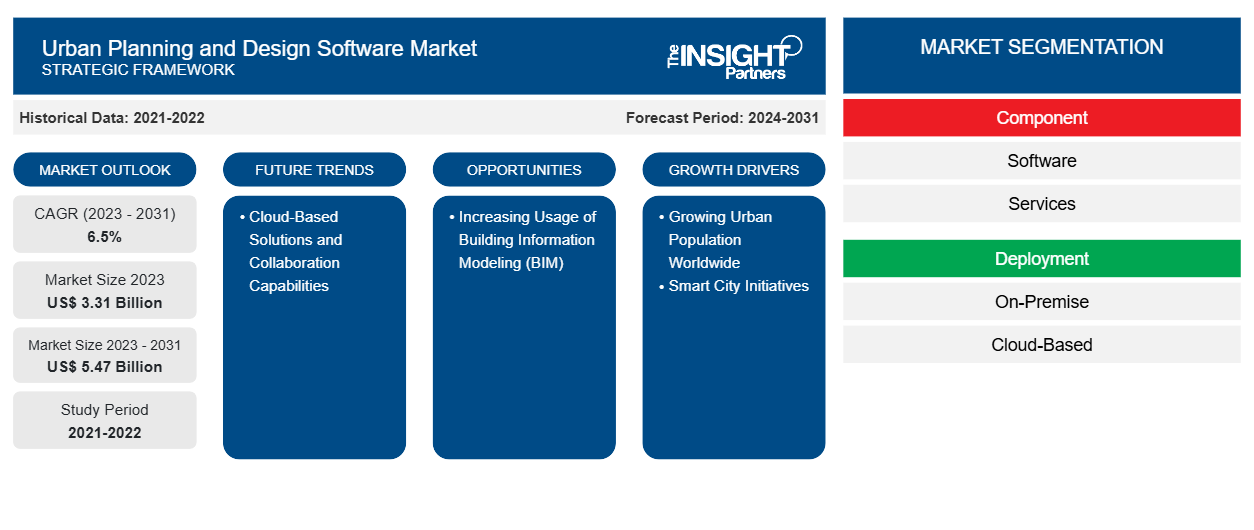Der Markt für Stadtplanungs- und -designsoftware soll von 3,31 Milliarden US-Dollar im Jahr 2023 auf 5,47 Milliarden US-Dollar im Jahr 2031 anwachsen. Der Markt wird zwischen 2023 und 2031 voraussichtlich eine durchschnittliche jährliche Wachstumsrate von 6,5 % verzeichnen. Die weltweit wachsende Stadtbevölkerung und Smart-City-Initiativen dürften weiterhin wichtige Trends auf dem Markt bleiben.
Marktanalyse für Stadtplanungs- und Designsoftware
Cloudbasierte Plattformen erfreuen sich aufgrund ihrer einfachen Implementierung und geringeren Kosten im Zuge der digitalen Transformation immer größerer Beliebtheit. Cloudbasierte Plattformen sind auch für Endbenutzer zugänglich, da die Internetinfrastruktur in Industrieländern aufgebaut wurde und in zahlreichen Entwicklungsländern wächst. Sicheres Hosting wichtiger Daten, verbesserte Sicherheit und Skalierbarkeit sowie schnelle Dateiwiederherstellung sind einige Vorteile von cloudbasierter Software für Stadtplanung und -design. Zur Speicherung von Backups wird eine private oder gemeinsam genutzte Cloud-Hosting-Plattform verwendet. So können wichtige Serverdaten von Organisationen umgehend wiederhergestellt werden. Darüber hinaus sind die Daten von jedem Standort aus mit sicheren Logins und einer zuverlässigen Internetverbindung leicht zugänglich . Darüber hinaus reduziert cloudbasierte Software für Stadtplanung und -design die Reparatur- und Wartungskosten und erhöht die Kundenzufriedenheit.
Marktübersicht für Stadtplanungs- und -design-Software
Software für Stadtplanung und -design wird verwendet, um 3D-Modelle städtischer Umgebungen zu erstellen und Stadtlayouts zu entwickeln. Architekten und Stadtplaner verwenden Software für Stadtplanung und -design, um zu visualisieren, wie ihre Pläne in der realen Welt aussehen könnten. Stadtplaner können ihre Empfehlungen für die Stadtplanung verbessern und Stadtlayouts erstellen, die den örtlichen Bebauungsvorschriften entsprechen, indem sie 3D-Visualisierungen erstellen. Benutzer können reale Strukturen automatisch in ihre Software für Stadtplanung und -design importieren, indem sie GIS-Software darin integrieren. Benutzer profitieren von Zeiteinsparungen und Stadtplaner können um die vorhandene Infrastruktur einer städtischen Umgebung herum konstruieren.
Passen Sie diesen Bericht Ihren Anforderungen an
Sie erhalten kostenlose Anpassungen an jedem Bericht, einschließlich Teilen dieses Berichts oder einer Analyse auf Länderebene, eines Excel-Datenpakets sowie tolle Angebote und Rabatte für Start-ups und Universitäten.
-
Holen Sie sich die wichtigsten Markttrends aus diesem Bericht.Dieses KOSTENLOSE Beispiel umfasst eine Datenanalyse von Markttrends bis hin zu Schätzungen und Prognosen.
Treiber und Chancen auf dem Markt für Stadtplanungs- und -designsoftware
Wachsende Stadtbevölkerung weltweit begünstigt Markt
Laut der Weltbank leben aktuell rund 56 % der Weltbevölkerung, also 4,4 Milliarden Einwohner, in Städten. Dieser Trend wird sich Prognosen zufolge fortsetzen: Bis 2050 wird sich die Stadtbevölkerung mehr als verdoppeln. Zu diesem Zeitpunkt werden fast sieben von zehn Menschen in Städten leben. Das kontinuierliche Wachstum der städtischen Bevölkerung weltweit wird Prognosen zufolge einen Bedarf an der Entwicklung neuer Strukturen schaffen, darunter sowohl Geschäfts- als auch Wohngebäude . Folglich entsteht eine Nachfrage nach Städteplanungs- und -entwurfssoftware, die den Bau dieser Infrastrukturen erleichtert. Unternehmen wie SketchUp (Trimble Inc.) bieten etwa Städteentwurfssoftware an, die Planer bei ihren Aufgaben unterstützt, indem sie computergestütztes Design (CAD) und Geolokalisierungstools im Toolkit des Städteplaners von SketchUp nutzt und es ihnen ermöglicht, von konzeptionellen Modellen zu Vorschlägen zu gelangen.SketchUp (Trimble Inc.) offer urban design software that aids planners in their tasks by leveraging computer-aided design (CAD) and geolocation tools within the SketchUp city planner's toolkit, enabling them to progress from conceptual models to proposals.
Zunehmende Nutzung von Building Information Modeling (BIM)
Building Information Modeling (BIM) ist eine hochmoderne Technologie, die in der Stadtplanung immer mehr an Bedeutung gewinnt. Dabei wird eine digitale Darstellung eines Gebäudes oder Infrastrukturprojekts entwickelt, die detaillierte Informationen zu dessen Entwurf, Bau und Instandhaltung enthält. Diese Daten werden in einer zentralen Datenbank gespeichert, auf die die verschiedenen am Projekt beteiligten Parteien von Anfang bis Ende zugreifen können. Durch den Einsatz von BIM erhalten Stadtplaner eine umfassende und aktuelle Sicht auf ein Projekt, was zu weniger Fehlern, verbesserter Kommunikation und schnelleren Bauprozessen führt. Darüber hinaus garantiert BIM, dass Projekte den höchsten Standards entsprechen und alle gesetzlichen Vorschriften einhalten.
Marktbericht zu Stadtplanungs- und Designsoftware – Segmentierungsanalyse
Wichtige Segmente, die zur Ableitung der Marktanalyse für Stadtplanungs- und -entwurfssoftware beigetragen haben, sind Komponente, Bereitstellung und Anwendung.
- Basierend auf den Komponenten ist der Markt in Software und Dienstleistungen segmentiert. Das Softwaresegment hatte im Jahr 2023 einen bedeutenden Marktanteil.
- In Bezug auf die Bereitstellung ist der Markt in On-Premises und Cloud-basiert unterteilt. Das On-Premises-Segment hielt im Jahr 2023 einen erheblichen Marktanteil.
- Basierend auf der Anwendung ist der Markt in Architekten, Stadtplaner und Kreativabteilungen segmentiert. Das Architektensegment hielt im Jahr 2023 einen bedeutenden Marktanteil.
Marktanteilsanalyse für Stadtplanungs- und Designsoftware nach geografischen Gesichtspunkten
Der geografische Umfang des Marktberichts für Städteplanungs- und -entwurfssoftware ist hauptsächlich in fünf Regionen unterteilt: Nordamerika, Asien-Pazifik, Europa, Naher Osten und Afrika sowie Süd- und Mittelamerika.
Nordamerika wird voraussichtlich einen erheblichen Umsatzanteil am Markt für Stadtplanungs- und -designsoftware halten. Dem Entwicklungsprogramm der Vereinten Nationen zufolge leben mehr als 60 % der Weltbevölkerung in Städten, davon sind mehr als 70 % der Erwerbstätigen; außerdem werden 80 % des weltweiten Wirtschaftswerts in Städten erwirtschaftet. Smart-City-Initiativen beinhalten die Einführung verschiedener intelligenter Technologien, darunter Stadtplanungs- und -designsoftware, die den Betrieb energieeffizienter und nachhaltiger machen und den Kohlenstoffausstoß minimieren. Daher wird erwartet, dass zunehmende Initiativen in Smart-City-Projekten im Prognosezeitraum verschiedene Möglichkeiten für Marktwachstum schaffen werden.
Regionale Einblicke in den Markt für Stadtplanungs- und Designsoftware
Die regionalen Trends und Faktoren, die den Markt für Stadtplanungs- und -designsoftware während des gesamten Prognosezeitraums beeinflussen, wurden von den Analysten von Insight Partners ausführlich erläutert. In diesem Abschnitt werden auch Marktsegmente und Geografien für Stadtplanungs- und -designsoftware in Nordamerika, Europa, im asiatisch-pazifischen Raum, im Nahen Osten und Afrika sowie in Süd- und Mittelamerika erörtert.

- Erhalten Sie regionale Daten zum Markt für Stadtplanungs- und -design-Software
Umfang des Marktberichts zu Stadtplanungs- und Designsoftware
| Berichtsattribut | Details |
|---|---|
| Marktgröße im Jahr 2023 | 3,31 Milliarden US-Dollar |
| Marktgröße bis 2031 | 5,47 Milliarden US-Dollar |
| Globale CAGR (2023 - 2031) | 6,5 % |
| Historische Daten | 2021-2022 |
| Prognosezeitraum | 2024–2031 |
| Abgedeckte Segmente |
Nach Komponente
|
| Abgedeckte Regionen und Länder |
Nordamerika
|
| Marktführer und wichtige Unternehmensprofile |
|
Dichte der Marktteilnehmer für Stadtplanungs- und -designsoftware: Die Auswirkungen auf die Geschäftsdynamik verstehen
Der Markt für Stadtplanungs- und -designsoftware wächst rasant. Dies wird durch die steigende Nachfrage der Endnutzer aufgrund von Faktoren wie sich entwickelnden Verbraucherpräferenzen, technologischen Fortschritten und einem größeren Bewusstsein für die Vorteile des Produkts vorangetrieben. Mit der steigenden Nachfrage erweitern Unternehmen ihr Angebot, entwickeln Innovationen, um die Bedürfnisse der Verbraucher zu erfüllen, und nutzen neue Trends, was das Marktwachstum weiter ankurbelt.
Die Marktteilnehmerdichte bezieht sich auf die Verteilung der Firmen oder Unternehmen, die in einem bestimmten Markt oder einer bestimmten Branche tätig sind. Sie gibt an, wie viele Wettbewerber (Marktteilnehmer) in einem bestimmten Marktraum im Verhältnis zu seiner Größe oder seinem gesamten Marktwert präsent sind.
Die wichtigsten Unternehmen auf dem Markt für Stadtplanungs- und -design-Software sind:
- Bentley Systems Incorporated
- Modellierung
- SIMWALK
- SketchUp
- UrbanFootprint
- Urbansim
Haftungsausschluss : Die oben aufgeführten Unternehmen sind nicht in einer bestimmten Reihenfolge aufgeführt.

- Überblick über die wichtigsten Akteure auf dem Markt für Stadtplanungs- und Designsoftware
Neuigkeiten und aktuelle Entwicklungen zum Markt für Stadtplanungs- und -designsoftware
Der Markt für Stadtplanungs- und -designsoftware wird durch die Erfassung qualitativer und quantitativer Daten nach Primär- und Sekundärforschung bewertet, die wichtige Unternehmensveröffentlichungen, Verbandsdaten und Datenbanken umfasst. Nachfolgend sind einige der Entwicklungen auf dem Markt für Stadtplanungs- und -designsoftware aufgeführt:
- Autodesk, Inc. (NASDAQ: ADSK) hat heute an der Autodesk University eine strategische Zusammenarbeit mit Epic Games bekannt gegeben, um immersive Echtzeiterlebnisse (RT) branchenübergreifend zu beschleunigen, wobei der Schwerpunkt zunächst auf Architektur, Ingenieurwesen und Bauwesen (AEC) liegt.
(Quelle: AUTODESK INC., Pressemitteilung, September 2022)
Marktbericht zu Stadtplanungs- und -design-Software – Umfang und Ergebnisse
Der Bericht „Marktgröße und Prognose für Stadtplanungs- und Designsoftware (2021–2031)“ bietet eine detaillierte Analyse des Marktes, die die folgenden Bereiche abdeckt:
- Marktgröße und Prognose für Stadtplanungs- und Designsoftware auf globaler, regionaler und Länderebene für alle wichtigen Marktsegmente, die im Rahmen des Berichts abgedeckt sind
- Markttrends und Marktdynamiken für Stadtplanungs- und Designsoftware wie Treiber, Einschränkungen und wichtige Chancen
- Detaillierte PEST/Porters Five Forces- und SWOT-Analyse
- Analyse des Marktes für Stadtplanungs- und -designsoftware mit Blick auf wichtige Markttrends, globale und regionale Rahmenbedingungen, wichtige Akteure, Vorschriften und aktuelle Marktentwicklungen
- Branchenlandschaft und Wettbewerbsanalyse, die die Marktkonzentration, Heatmap-Analyse, prominente Akteure und aktuelle Entwicklungen für den Markt für Stadtplanungs- und Designsoftware umfasst
- Detaillierte Firmenprofile
- Historische Analyse (2 Jahre), Basisjahr, Prognose (7 Jahre) mit CAGR
- PEST- und SWOT-Analyse
- Marktgröße Wert/Volumen – Global, Regional, Land
- Branchen- und Wettbewerbslandschaft
- Excel-Datensatz
Aktuelle Berichte
Verwandte Berichte
Erfahrungsberichte
Grund zum Kauf
- Fundierte Entscheidungsfindung
- Marktdynamik verstehen
- Wettbewerbsanalyse
- Kundeneinblicke
- Marktprognosen
- Risikominimierung
- Strategische Planung
- Investitionsbegründung
- Identifizierung neuer Märkte
- Verbesserung von Marketingstrategien
- Steigerung der Betriebseffizienz
- Anpassung an regulatorische Trends























 Kostenlose Probe anfordern für - Markt für Stadtplanungs- und Designsoftware
Kostenlose Probe anfordern für - Markt für Stadtplanungs- und Designsoftware